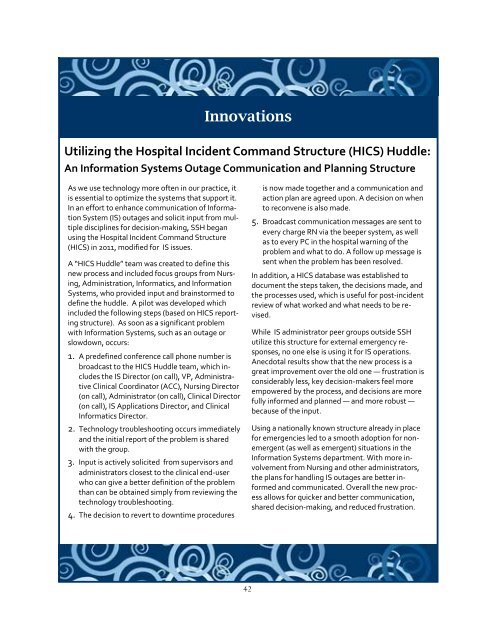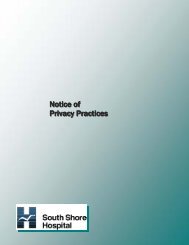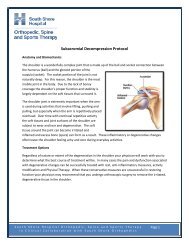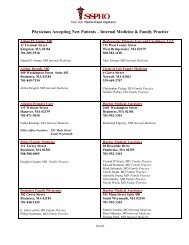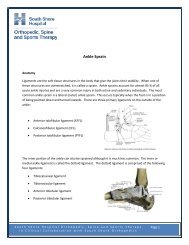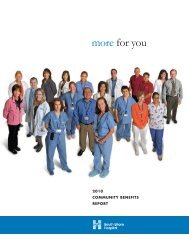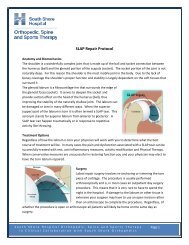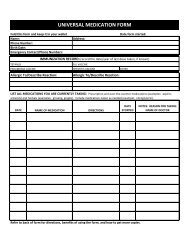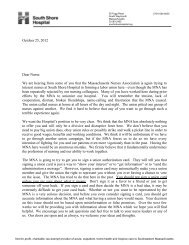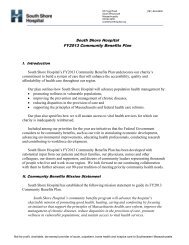2011 Nursing Annual Report - FINAL.pub - South Shore Hospital
2011 Nursing Annual Report - FINAL.pub - South Shore Hospital
2011 Nursing Annual Report - FINAL.pub - South Shore Hospital
You also want an ePaper? Increase the reach of your titles
YUMPU automatically turns print PDFs into web optimized ePapers that Google loves.
InnovationsUtilizing the <strong>Hospital</strong> Incident Command Structure (HICS) Huddle:An Information Systems Outage Communication and Planning StructureAs we use technology more often in our practice, itis essential to optimize the systems that support it.In an effort to enhance communication of InformationSystem (IS) outages and solicit input from multipledisciplines for decision‐making, SSH beganusing the <strong>Hospital</strong> Incident Command Structure(HICS) in <strong>2011</strong>, modified for IS issues.A “HICS Huddle” team was created to define thisnew process and included focus groups from <strong>Nursing</strong>,Administration, Informatics, and InformationSystems, who provided input and brainstormed todefine the huddle. A pilot was developed whichincluded the following steps (based on HICS reportingstructure). As soon as a significant problemwith Information Systems, such as an outage orslowdown, occurs:1. A predefined conference call phone number isbroadcast to the HICS Huddle team, which includesthe IS Director (on call), VP, AdministrativeClinical Coordinator (ACC), <strong>Nursing</strong> Director(on call), Administrator (on call), Clinical Director(on call), IS Applications Director, and ClinicalInformatics Director.2. Technology troubleshooting occurs immediatelyand the initial report of the problem is sharedwith the group.3. Input is actively solicited from supervisors andadministrators closest to the clinical end‐userwho can give a better definition of the problemthan can be obtained simply from reviewing thetechnology troubleshooting.4. The decision to revert to downtime proceduresis now made together and a communication andaction plan are agreed upon. A decision on whento reconvene is also made.5. Broadcast communication messages are sent toevery charge RN via the beeper system, as wellas to every PC in the hospital warning of theproblem and what to do. A follow up message issent when the problem has been resolved.In addition, a HICS database was established todocument the steps taken, the decisions made, andthe processes used, which is useful for post‐incidentreview of what worked and what needs to be revised.While IS administrator peer groups outside SSHutilize this structure for external emergency responses,no one else is using it for IS operations.Anecdotal results show that the new process is agreat improvement over the old one — frustration isconsiderably less, key decision‐makers feel moreempowered by the process, and decisions are morefully informed and planned — and more robust —because of the input.Using a nationally known structure already in placefor emergencies led to a smooth adoption for nonemergent(as well as emergent) situations in theInformation Systems department. With more involvementfrom <strong>Nursing</strong> and other administrators,the plans for handling IS outages are better informedand communicated. Overall the new processallows for quicker and better communication,shared decision‐making, and reduced frustration.42


